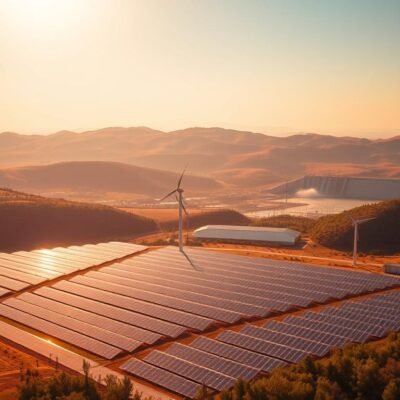
Ocean power is stepping into the spotlight as marine renewable solutions gain momentum. By 2025, devices designed to capture kinetic energy from moving water will play a bigger role in clean electricity production. The market for these systems is booming, with projections showing a jump from $19.54 billion to $26.59 billion by 2032.
What makes this moment unique? Breakthroughs in materials and smart tech are making converters more efficient. Artificial intelligence now optimizes performance, while durable designs withstand harsh ocean conditions. These improvements cut costs and boost reliability, making marine power a stronger competitor against traditional renewables.
Governments worldwide are backing this shift. Policies supporting clean energy adoption and carbon reduction goals are driving investments. Coastal regions, especially in the U.S., are testing large-scale projects to prove the viability of these systems for grid use.
You’ll see how next-gen engineering merges with environmental priorities to reshape global power networks. From startups to established energy giants, innovators are racing to refine conversion methods and expand applications. Let’s dive into the trends, players, and opportunities defining this transformative phase.
Key Takeaways
- Global market value for wave-powered systems hits $19.54 billion in 2025
- AI-driven designs improve efficiency and reduce operational costs
- Government incentives accelerate project deployments in coastal areas
- New materials enhance durability in challenging marine environments
- Private and public sectors collaborate to scale sustainable solutions
Overview of the Global Wave Energy Converter Market
Harnessing ocean movements is becoming a cornerstone of renewable strategies worldwide. Analysts project steady expansion as coastal nations tap into marine resources. This sector’s momentum reflects both environmental urgency and economic opportunity.
Market Valuations and Growth Predictions
Right now, marine power systems hold a $19.54 billion valuation, with Europe claiming 38% of that pie. Countries like Scotland and Portugal benefit from ideal coastlines and government backing. By 2032, experts see this figure rising to $26.59 billion – a 4.5% annual growth rate.
Wave-based tech dominates the sector, holding 41.1% of all marine energy investments. Solar and wind remain competitors, but price drops in converter systems are narrowing the gap. Investors increasingly view these projects as viable long-term plays.
Key Drivers Behind Market Expansion
Three factors are supercharging this growth:
- Governments setting aggressive carbon-neutral deadlines
- Material science breakthroughs extending equipment lifespans
- AI optimization cutting maintenance costs by up to 30%
You’ll notice coastal U.S. states accelerating pilot programs, too. California’s recent 20-megawatt installation highlights how policy meets innovation. As storage solutions improve, expect more regions to adopt these systems for grid stability.
Technological Advancements in Wave Energy Conversion
Engineers are rewriting the rules for harvesting ocean power through groundbreaking mechanical designs. Two innovations stand out: streamlined generator systems and smarter approaches to variable conditions.

Direct-Drive Linear Generators
You’ll notice traditional hydraulic systems getting replaced by direct-drive units that cut energy loss. These units convert motion to electricity in one step, eliminating complex fluid mechanics. CorPower Ocean’s C4 device shows why this matters – its 70% efficiency rate beats older models by 25%.
Multi-Frequency Energy Capture
Imagine devices adapting to sea rhythms like surfers reading swells. New adaptive designs now pull power from choppy waves and gentle swells alike. This flexibility means steadier output – crucial for making marine power grid-ready.
Maintenance costs tell the real story. Annual downtime dropped from 25% to 8% in recent trials, slashing energy prices by $50-$80 per MWh. You can expect even better performance as companies refine these systems through ongoing testing.
AI and Digital Optimization in Wave Energy Technologies
Artificial intelligence now drives unprecedented efficiency in marine power systems. Sensors and machine learning work together to analyze ocean patterns, tweaking operations every second. This optimization isn’t just theoretical – it’s cutting costs while boosting output across coastal installations.
Real-Time Monitoring and Predictive Maintenance
You’ll find companies like Ocean Power Technologies using smart algorithms to spot issues before they escalate. Their systems process live data from buoys and turbines, predicting wear on components weeks in advance. This approach slashes repair expenses by 40% compared to traditional methods.
CorPower Ocean takes it further. Their converters automatically adjust tilt angles and resistance based on wave height forecasts. During a March 2025 trial, this AI-driven strategy increased energy capture by 22% during storm conditions.
Case Studies of AI Integration in Product Design
Mocean Energy’s Blue X platform shows what’s possible. By feeding historical performance data into neural networks, they reduced unplanned downtime to just 3 hours per year. You benefit from steadier power delivery to grids without manual interventions.
Recent funding moves prove this shift isn’t temporary. Vinnova’s March 2025 investment in CorPower targets AI upgrades that could halve operational costs within 18 months. As these tools learn from real-world data, they’ll keep refining energy technology for harsher marine environments.
Global Research and Development Initiatives

Partnerships between universities and corporations are turbocharging marine power breakthroughs. These alliances blend academic creativity with industrial pragmatism, creating solutions that work in labs and oceans. You’ll see why this teamwork matters more than ever.
Collaborations Between Research Institutions and Industry Leaders
National labs tackle big questions like material durability under extreme conditions. Private firms then transform those findings into market-ready products. Take the U.S. Department of Energy’s $112.5 million initiative – it funds real-world testing of prototypes developed through these partnerships.
This model slashes timelines. Academic teams handle exploratory research while companies manage manufacturing and financing. You get viable systems faster because both sides focus on their strengths.
Impact of Public Funding and Grant Announcements
Government investments de-risk innovation. Five-year commitments like the DOE’s open-water testing program let engineers refine designs through multiple seasons. You benefit from technologies validated in actual waves, not just simulations.
Public funding also attracts private capital. When federal grants back high-potential projects, venture firms follow. This combo speeds progress toward affordable, scalable marine renewable systems.
Understanding The future of wave energy converters in 2025
Marine power solutions are entering a critical phase of global adoption. Climate commitments and tech advancements create perfect conditions for growth. Let’s explore what’s pushing this sector forward and how rules shape its progress.
Three Forces Accelerating Adoption
You’re seeing unprecedented alignment between environmental needs and technical capabilities. First, international climate agreements push nations to seek renewable energy alternatives beyond solar and wind. Second, material innovations help devices survive harsh ocean environments longer. Third, AI-driven efficiency gains make projects financially viable.
Europe leads with concrete targets like installing 1 GW of marine power by 2030. Similar initiatives emerge in Australia and along North American coastlines. These efforts prove wave energy can complement existing clean power grids effectively.
How Rules Shape Project Success
Governments use two tools to boost this sector: money and mandates. Feed-in tariffs guarantee above-market rates for marine power, while tax credits offset installation costs. In the U.S., new bills offer 30% investment tax credits for coastal energy projects.
Regulators also simplify permit processes for offshore testing zones. This speeds up development cycles – a game-changer for startups needing quick iterations. With these policy supports, analysts predict 400% growth in operational wave farms by 2026.
You’ll notice more countries adding marine power targets to their climate plans. This creates stable demand, encouraging private investment in next-gen converter designs. The combination of ecological urgency and smart regulation makes 2025 a pivotal year.
Current Events Shaping the Sector
Recent partnerships are proving wave energy’s readiness for real-world implementation. From remote communities to bustling ports, projects now demonstrate practical solutions for coastal power needs.
Recent Funding and Deployment Milestones
You’ll find momentum building with CalWave’s March 2024 selection for a groundbreaking initiative in British Columbia. Their modular systems will power Yuquot’s micro-grids through an indigenous-led partnership backed by TD Bank Group. This collaboration highlights how financial institutions now prioritize community-focused renewable projects.
Across the Atlantic, CETO Wave Energy Ireland secured testing access at Spain’s BiMEP facility. Their 2025 trials aim to validate technology for European markets. Meanwhile, Eco Wave Power’s April 2025 manufacturing deal signals U.S. expansion – floaters for Los Angeles’ port project will roll out domestically.
Highlights from Major Industry Conferences
Global forums spotlight these advancements as proof of sector maturation. “We’re shifting from prototypes to profit-generating installations,” noted a speaker at April’s Ocean Energy Council summit. Discussions emphasized multi-regional strategies, with projects spanning Canada, Europe, and California showing adaptable solutions.
You’re seeing three patterns emerge:
- Bankable partnerships between tech firms and local communities
- Accelerated testing timelines through international collaboration
- Production scaling for coastal urban applications
Government Policies and Their Environmental Impact
Coastal nations are racing to unlock the potential of their shorelines through smart regulations. Strategic policy frameworks now drive both ecological protection and economic growth, creating win-win scenarios for communities and ecosystems.
Global Commitments and Renewable Energy Targets
You’ll see concentrated efforts in regions like Portugal and Scotland, where governments blend subsidies with strict emission rules. The EU’s 1 GW ocean capacity goal by 2030 acts as a blueprint, combining feed-in tariffs with research grants. These measures reduce carbon footprints while building local expertise in sustainable energy tech.
Policy Support in the U.S. and Europe
American coastal states now offer 30% tax credits for marine power installations, mirroring Canada’s decade-long incentive programs. Europe accelerates progress through simplified permitting – projects get faster approvals in designated test zones. This renewable energy push cuts deployment risks, attracting private investors to scale proven solutions.
These strategies don’t just fund prototypes. They create hubs where manufacturers, researchers, and engineers collaborate. You benefit from cleaner grids and protected marine habitats as energy systems evolve responsibly.

